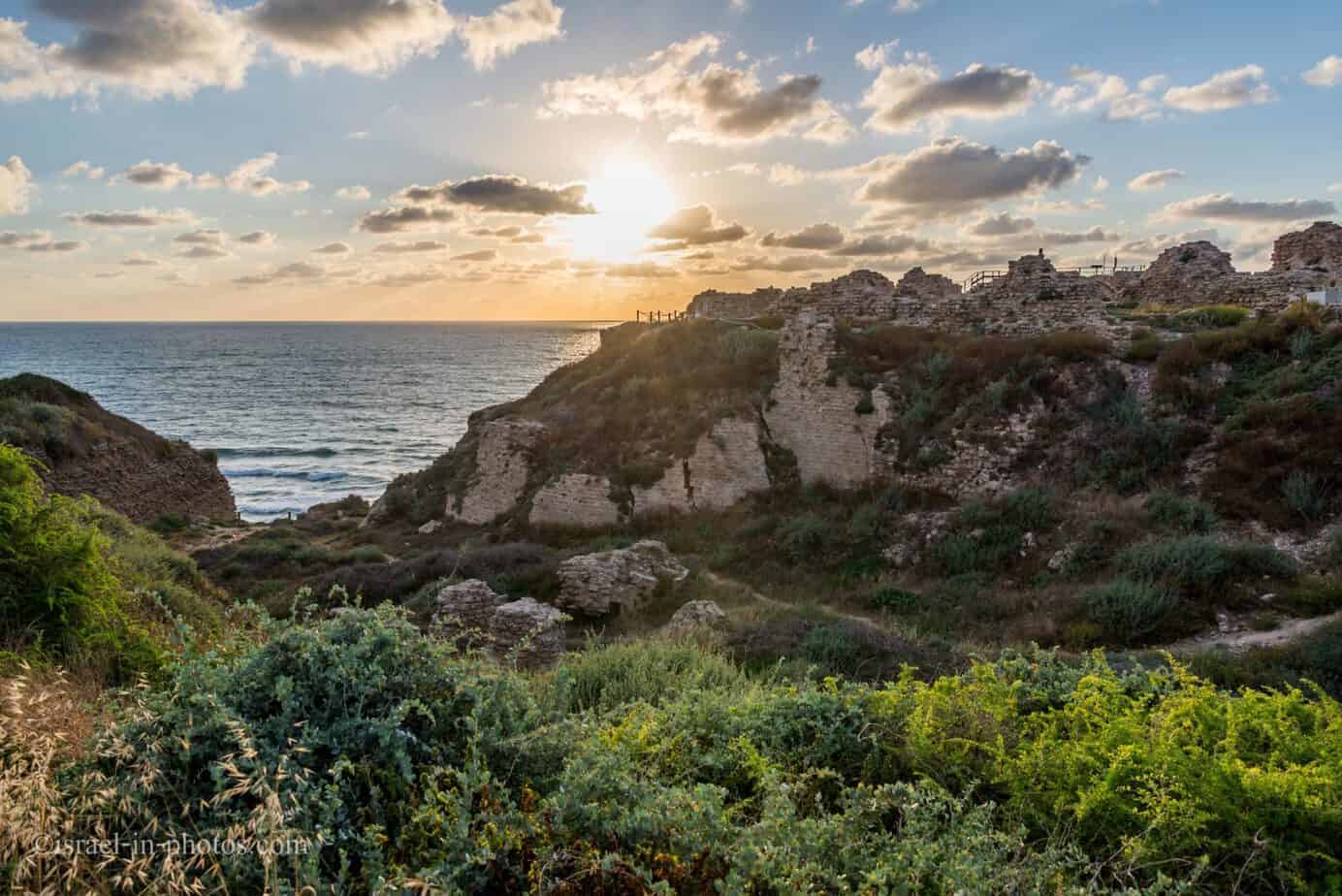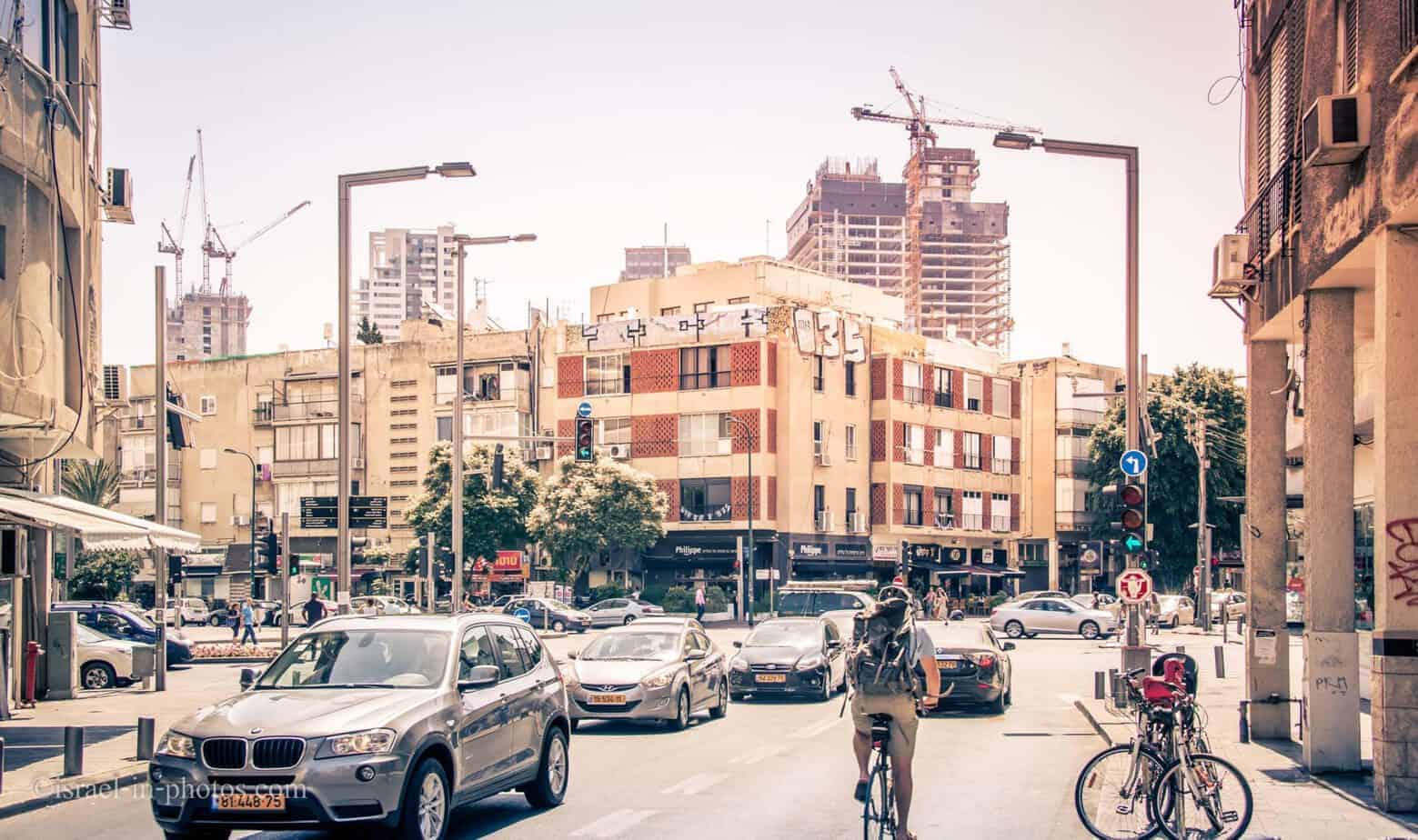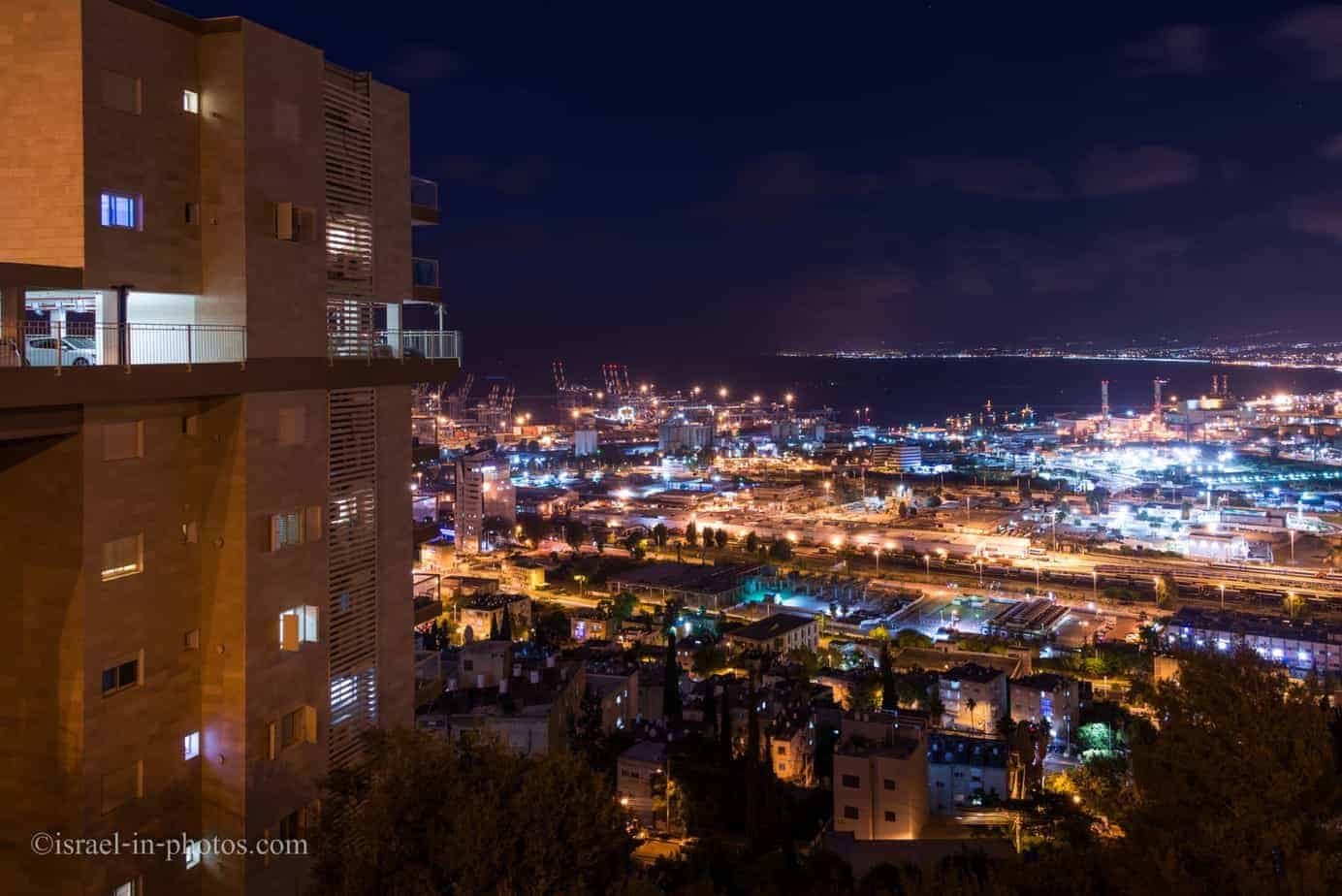Apollonia National Park (Arsuf Fortress) – Visitors Guide
Apollonia National Park (Arsuf), located north of Herzliya, features a seaside Crusader Fortress and a wheelchair-accessible path.
Table of Contents
Map
Apollonia (Arsuf) National Park is located on the Mediterranean seashore north of Herzliya and about 30 km south of Caesarea. It is situated on Kurkar (calcareous sandstone), about 30 meters above sea level.
You can get directions using the following links, and there is free parking near the site’s entrance.
Directions for drivers: Link to Waze and Link to Google Maps
Directions for public transport: Link to Moovit
Interactive map of the area:
Here is a map of the national park (from the official brochure):

As you can see from the map’s scale (50 meters), this national park is not big. The length of the trail is around 2 km.
Opening Hours
Sunday – Thursday and Saturday: 8:00 – 17:00 (16:00 in winter).
Friday: 8:00 – 16:00 (15:00 in winter).
On holiday eves, usually 8:00 – 13:00.
Note: Since the pandemic, the Israel Nature and Parks Authority has started limiting the number of people in each park. Thus, reservations are recommended through the official site (you can find the link below).
Entrance Fee
Adult 24 NIS, child 10 NIS, and student 20 NIS. Free for National Parks annual subscribers.
If you visit multiple National Parks, consider purchasing a combo ticket. Additional information is available at National Parks and Nature Reserves.
Note: opening hours and ticket prices were updated in May 2024. In any case, recheck the official site before visiting.
Contact Information
Phone: 09-9550929
Website: official site

Tours
As in other national parks, the Israeli Nature And Parks Authority occasionally offers free tours (at no extra cost beyond the entrance fee). These tours are usually during Spring, Summer Weekends, and Holidays. For additional information about the tours and concerts, visit the official site or call the Central District Training Unit at 08-6220835.
Concerts
During the summer, the inner part of the fortress becomes a small concert hall. The shows are usually held in the summer evening during sunset (around 19:00 – 20:00). Since it is after the closing hours of the national park, you need to buy dedicated tickets. Several years ago, we attended a concert costing around 60 NIS per person. For such a price, you will not get top-rank performers but a lovely Jazz band with a sunset view and a sea breeze. And if you come early, you will also have time (about half an hour to maybe an hour) to walk in the park. You can find the timetable of the performers on the official site during the summer.
Wheelchair-accessible Trail
Recently, the park was upgraded, and a new road for wheelchair users was built. Hence, you can visit almost the whole park with a baby stroller.
Moat
As you enter the site, you will see a dry moat that protected the Crusader’s town.



The city moat – the southern side of the city moat was excavated in 1998 and helped us to estimate the size and strength of the city in Crusader times. In 1996 the eastern city gate, which still lies in grounds belonging to IMI (Israel Military Industries), was excavated. The moat can be seen to continue beyond the excavated area, and it is about 4.5 m deep.
Note: unless stated otherwise, all quotes were taken from the official site.
Samaritan Synagogue
Near the end of the city moat, you can find the remains of a Samaritan Synagogue.
The mosaic floor from the Byzantine period (4th-5th centuries CE) is probably a relic of a Samaritan synagogue. This assumption is based on the bilingual inscription (Greek and Aramaic in the Samaritan script) at its center. While the translation of the Greek is “One only god / who helps / Gadiona / and lulianus / and all who deserve it,” that of the Aramaic (written in Samaritan script) may be translated as “(made it from his) possession in this place.” A rounded niche set in the southern wall of the building (mihrab?) may imply that the building served as a Muslim house of worship in the Early Islamic period (7th-8th centuries CE).
Source: sign




Roman Villa
Near the viewpoint shown in the photo above, you can find the Roman Villa.
The Roman seaside villa—At the beginning of the 1980s, a small part of the Roman villa was excavated, but it was only after intensive excavations in 1998 that the villa was revealed in all its glory. The Roman villa, overlooking the sea, is dated to the 1st century CE and was destroyed in an earthquake in 118 CE.

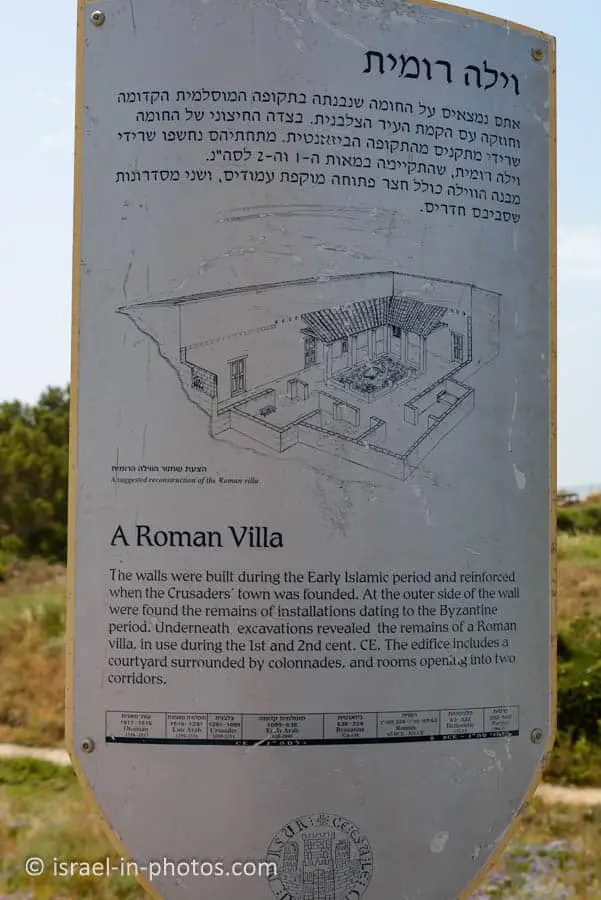
Here are several additional photos from the park:
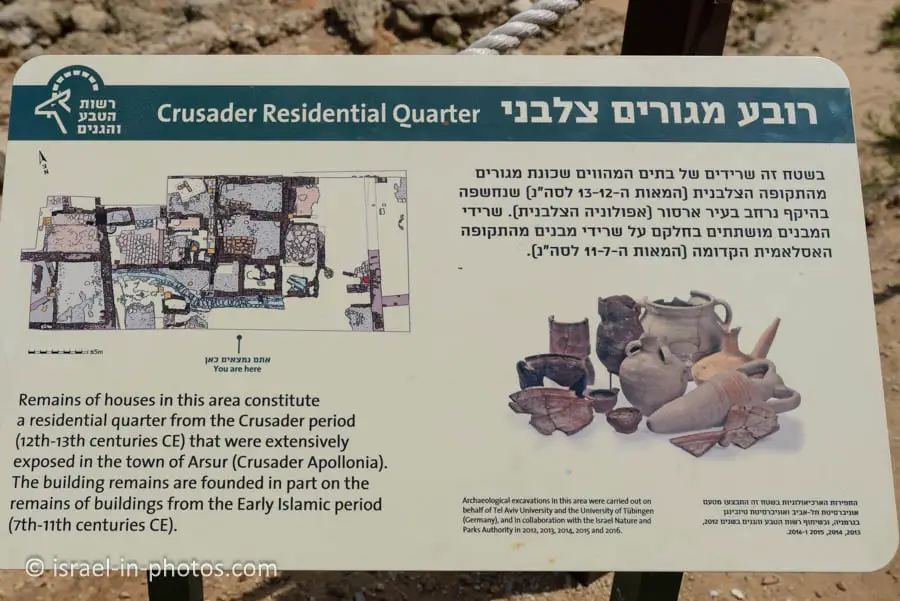
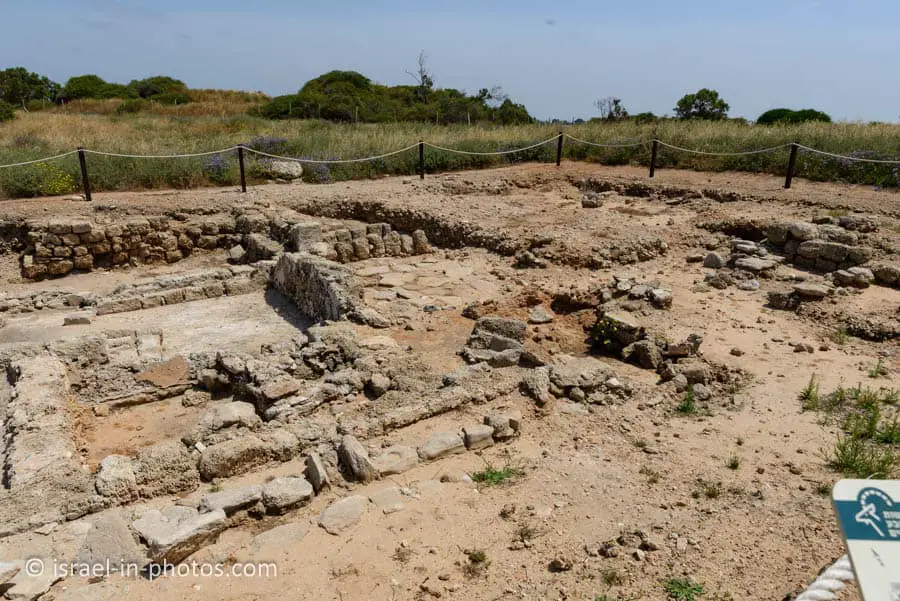






You can see Herzliya, Tel Aviv, Jaffa, and even the port of Ashdod. And when looking to the other side, you will see the Crusader fortress.



Crusader Fortress
Several photos of the Crusader fortress:
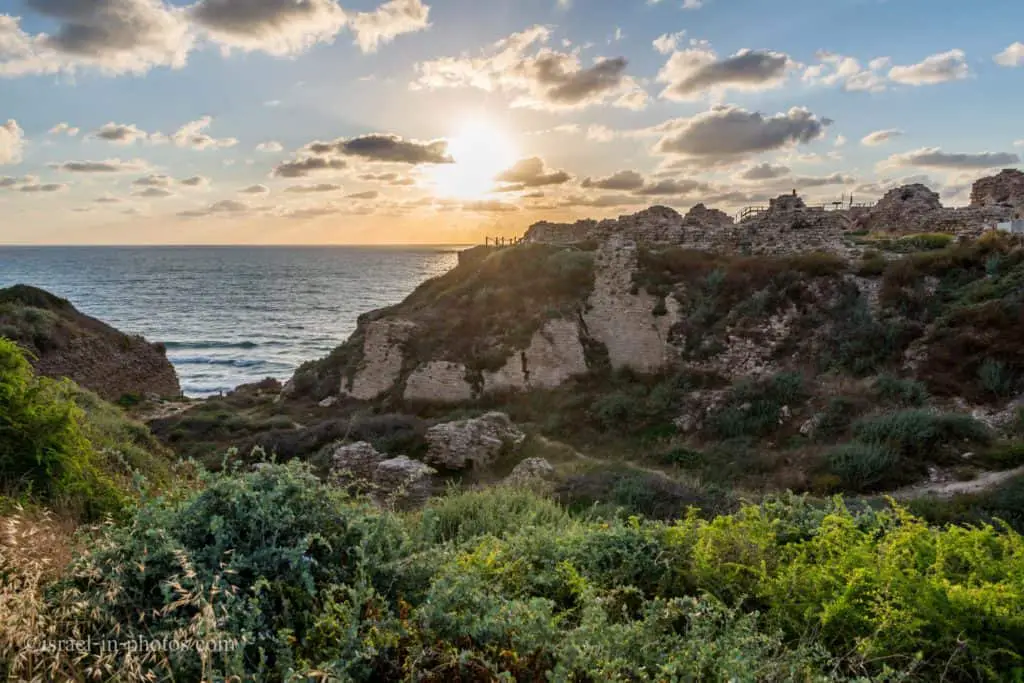



The Crusaders also protected the fortress with a dry moat (in addition to the one that protected the city). The trench was 27 meters wide and 13 meters deep. Entry to the fort was through the bridge. Here, you can see a drawing of the suggested reconstruction.
All this defense did not help, and in 1265 CE, the Crusader fortress fell to the Mameluke Sultan Baibars. The Mameluke army filled the moat with wooden logs. The absence of the trench allowed them to bring siege machines close to the walls. After forty days of siege, the town fell.


The Crusader fortress – construction of the fortress is dated to 1241, and its destruction to 1265, when the Mameluke Sultan Baibars captured the city.
The fortress building was influenced by similar fortresses in southern England and is evidence that the architect was European. It has three systems of fortification: a wide and deep moat, a first wall (the external fortification array), and a second wall and donjon (keep).
The fortress was built by Balian of Ibelin, Lord of Arsur, but in 1261, at the start of Baibars’ campaign to the land of Israel, it was handed over, along with the entire city of Apollonia, to the control of the Hospitaller Knights.
Baibars besieged the city for 30 days, and the fortress for another three days. At the foot of the fortress is a small sea anchorage at which boats could tie-up.


The remains of the keep are the highest point in the castle today. At nine meters in height, it served as an internal defense system. Today, it is an excellent place for photographing. I took the following photos from the keep.

Here is a closeup of the previous photo. You can see one of the viewpoints and Herzliya beach:
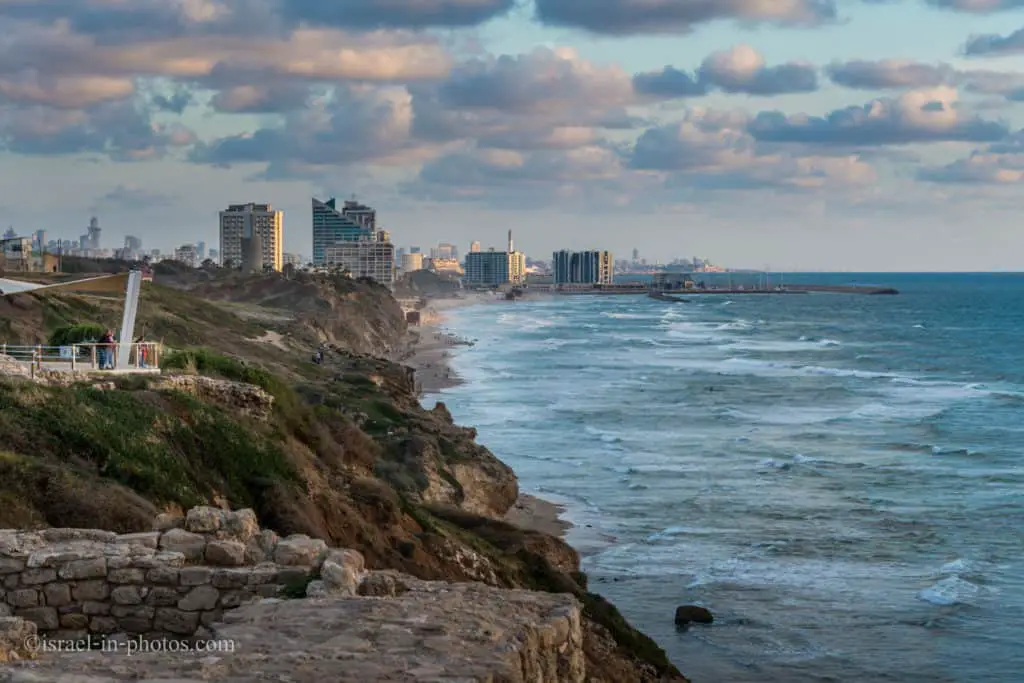
That was a view to the South. When looking to the West, you will see the sea:

To the North, we see Netanya.

Between this park and Netanya, there is another lovely place near the sea. It is called Sharon Beach National Park, and if you are looking for a hike, check it out.

The high buildings in the photograph above belong to Netanya’s neighborhood, Ir Yamim. Just beside this block, you can find Nahal Poleg Nature Reserve. If you visit during the Spring, consider seeing the blooming of Coastal Iris.
Here are additional photos from the keep and the fortress:

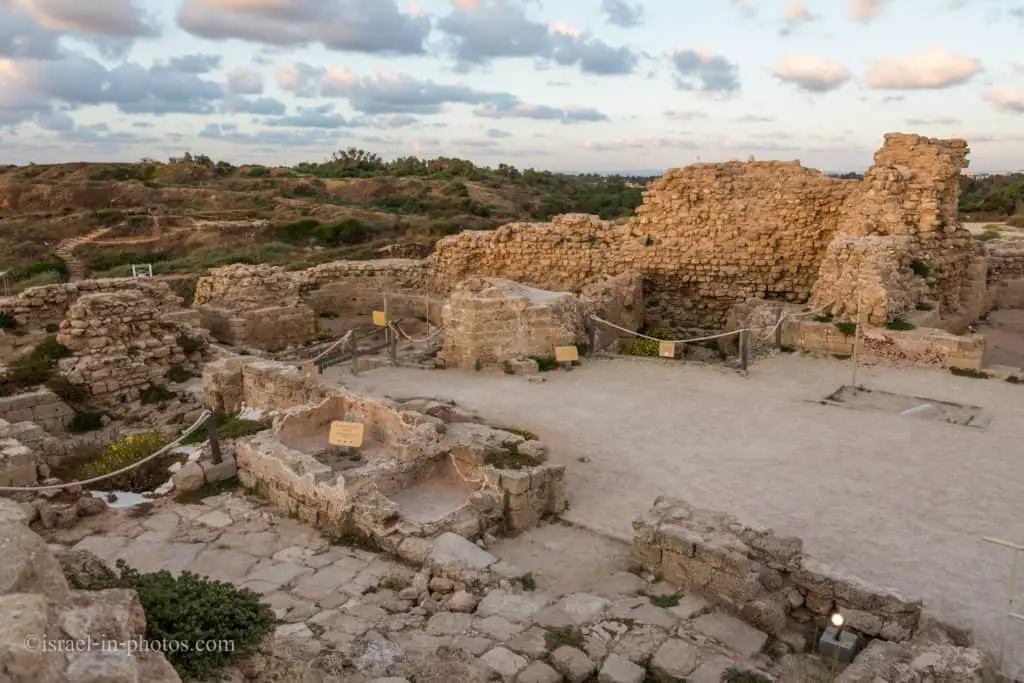

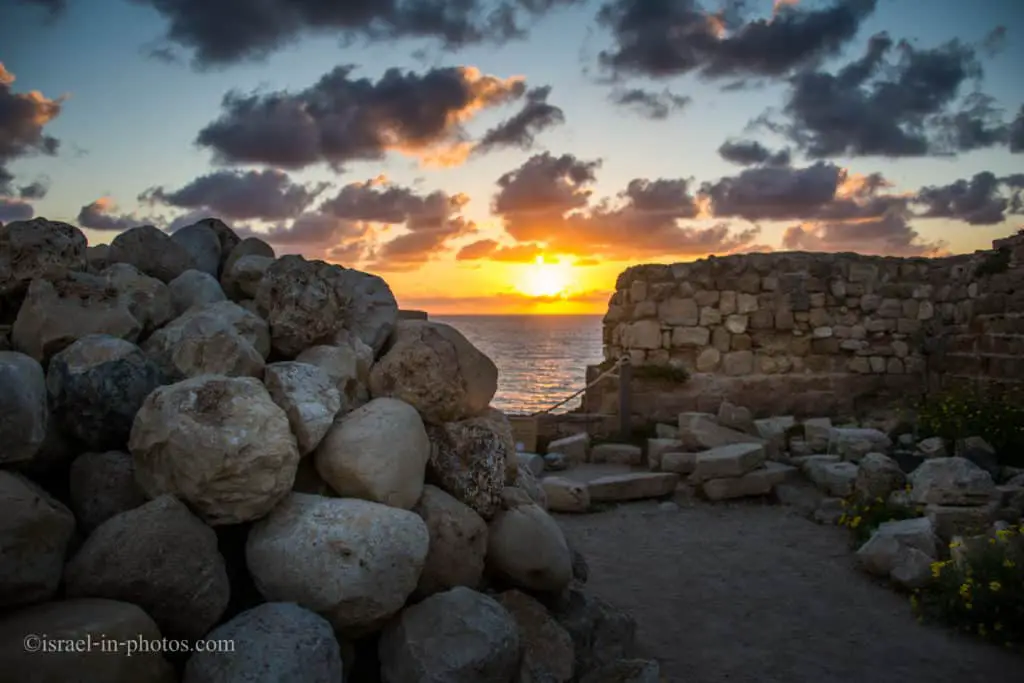

Winepress
You are looking at a winepress (wine-making facility) from the Byzantine period (4th-5th centuries CE). It consists of a partially preserved treading floor (north) and a particularly large rounded collecting vat (south). In the center of the treading floor, there is an inscription in Greek. It reads: “One God only, help / Cassianos together with (his) wife / and children and everyone.” The inscription and other finds discovered in the winepress area suggest that the winepress was owned by a Samaritan, probably until the Samaritan revolt that occurred in 529 CE.
In the late Byzantine period (from the middle of the 6th century CE) the winepress was deliberately filled and its area was occupied by primary glass furnaces for the production of raw glass, similar to the furnace that can be seen at the entrance to Apollonia National Park.
Source: sign



Note: The Israeli Nature And Parks Authority says that Apollonia is one of the best places to see Air Force planes fly during Independence Day.
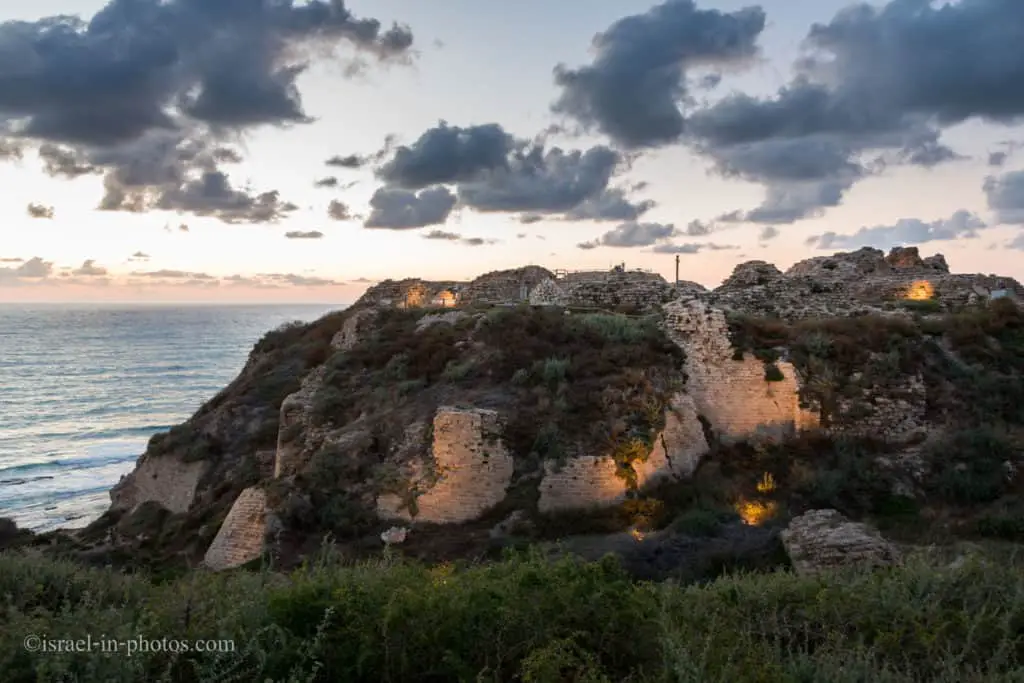
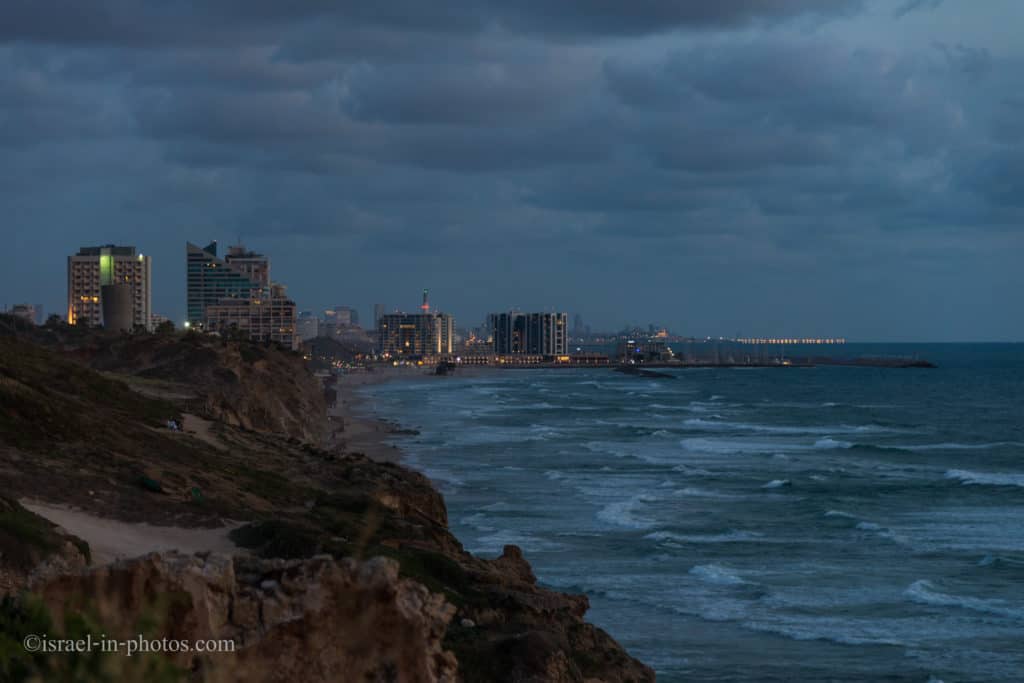
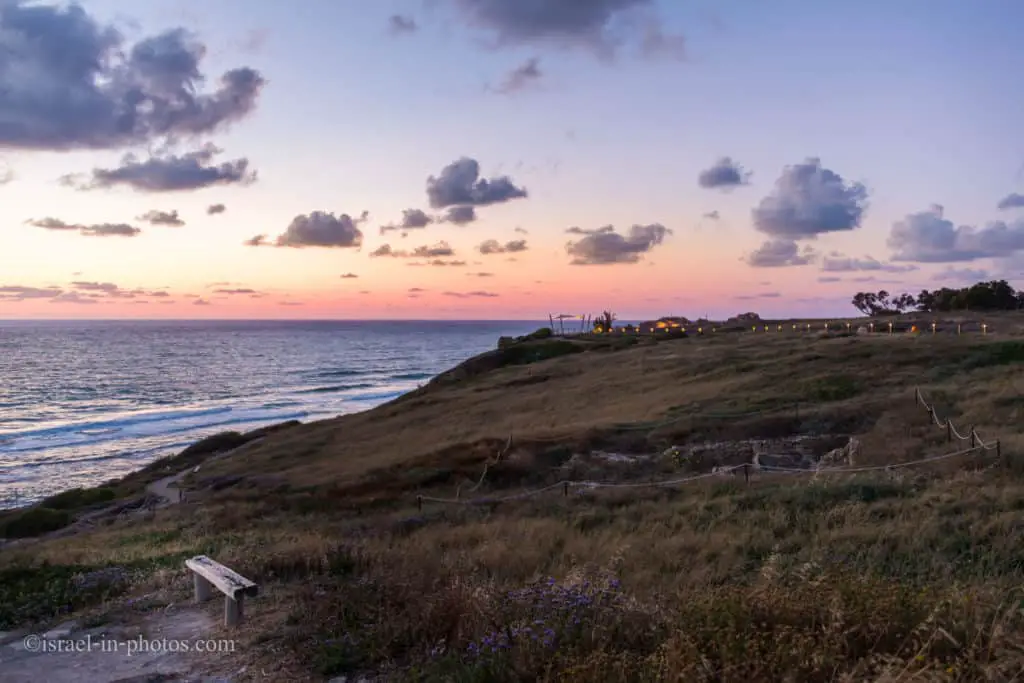
Historical Extract – The Three Names Of Apollonia
Historical background from Wikipedia:
Reshef
The town was settled by Phoenicians in the 6th or 5th century BC and named Reshef after Resheph, the Canaanite god of fertility and the underworld. It was then a part of the Persian Empire and governed by Sidon. Phoenicians of Reshef produced the precious purple dye, derived from murex mollusks, which they exported to the Aegean.
Apollonia
During the Hellenistic period, it was an anchorage town, ruled by Seleucids and renamed Apollonia, as the Greeks identified Phoenician God Reshef with Apollo.
Under Roman rule, the size of the town increased. It was an essential settlement between Jaffa and Caesarea along Via Maris, the coastal road. In 113 AD, Apollonia was destroyed partially by an earthquake but recovered quickly. The harbor was built, and trade with Italy and North Africa developed.During the Byzantine period, the town extended to cover an area of 70 acres (280,000 square meters). In the 5th and 6th century AD, it was the second-largest city in Sharon Valley, after Caesarea, populated by Christian and Samaritans, having an elaborate church and a prosperous glass industry.
Arsuf
In 640 AD, the town was captured by Muslims, and the Semitic name Arsuf was restored as an Arabic transliteration of Reshef. The town’s area decreased to about 22 acres (89,000 square meters), and, for the first time, it was surrounded by a fortified wall with buttresses to resist the constant attacks of Byzantine fleets from the sea. Large marketplaces appeared, and pottery production developed. In 809 AD, following Harun al-Rashid’s death, the local Samaritan community was destroyed and their synagogue ruined.
In 1101, Arsuf fell to a Crusader army led by Baldwin I of Jerusalem. The Crusaders, who called it Arsur, rebuilt the city’s walls and created the Lordship of Arsur in the Kingdom of Jerusalem. In 1187 Arsuf was captured by the Muslims but fell again to the Crusaders on September 7, 1191, after a battle between Richard I of England and Saladin.
Summary
Apollonia National Park is not a big place, and if you take a tour, which I always advise, it will last about an hour. Moreover, the park is wheelchair accessible, making it suitable for all ages, including family trips with baby strollers.
Another plus is that Apollonia National Park is close to the center. A drive from Tel Aviv (not during rush hour) will take 15-20 minutes, and a bus commute will take about an hour.
Overall, if you like archaeology and history and enjoy sea views, I suggest visiting Apollonia, especially during Spring. I would advise visiting Apollonia either by joining a tour or a concert. But, if this is your first time in Israel and you can visit only one place between Tel Aviv and Haifa, I suggest checking out Caesarea National Park.
Have you visited Apollonia National Park? Tell us about your experience in the comments below.
That’s all for today, and I’ll see you in future travels!
Stay Tuned!
For additional points of interest nearby, see Tel Aviv-Yafo.
Additional Resources
Here are several resources that I created to help travelers:- Trip Planner with Attractions and Itineraries is the page that will help you create your perfect travel route.
- What is the Best Time to visit Israel? To answer this question, we will consider the weather, prices, holidays, festivals, and more.
- Information and Tips for Tourists to Israel will answer the most common questions tourists have about Israel (including safety, passports, weather, currency, tipping, electricity, and much more).
- Israel National Parks and Nature Reserves include a complete list, top ten, map, tickets (Israel Pass, Matmon, combo), and campsites.
- If you are looking for things to do, here are the pages for Jerusalem, Tel Aviv, Haifa, Sea Of Galilee, Akko (Acre), Eilat, Nazareth, Safed (Tzfat), and Makhtesh Ramon.

